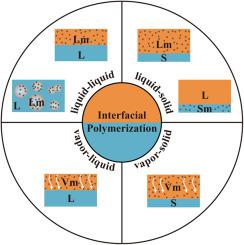Synthetic Metals ( IF 4.0 ) Pub Date : 2021-01-13 , DOI: 10.1016/j.synthmet.2020.116693 Nan Gao , Jiarui Yu , Shuai Chen , Xing Xin , Ling Zang

|
Nanostructured conducting polymers (NCPs) have been extensively studied in various organic electronic fields because of their unique, excellent structural, mechanical, electric and photoelectric properties at the nanoscale. The sizes and morphologies of NCPs, which are highly dependent on the original molecular structure and synthesis optimization, play critical roles in the applications involving NCP materials. As a promising strategy among the chemical oxidative polymerization methods, interfacial polymerization (IP) has been used in creation of abundant NCP materials through facilely controlled interfacial oxidative reactions. Here, we present a special review on the research progress of tunable IP involving different interfaces (liquid-liquid, liquid-solid, vapor-solid and vapor-liquid), wherein the precursor monomers can be positioned in either of the two phases. Such highly tunable interfacial fabrication has been proven an effective method for making NCPs and their composites both with controllable structure and properties. The nanostructured materials fabricated therefrom have found broad, increasing applications in supercapacitor, sensor, corrosion protection and other fields as discussed as well in this review. Also given at the end of this review are a summary and prospective overview about the current research issues and future development. It is expected that this review will provide systematic assistance and inspire new ideas for the development of interfacial processing technique in the field of nanostructured polymers.
中文翻译:

界面聚合可控地制备纳米结构导电聚合物及其复合材料
纳米结构导电聚合物(NCP)由于在纳米尺度上具有独特,优异的结构,机械,电和光电性能,因此已在各种有机电子领域中得到了广泛研究。NCP的大小和形态高度依赖于原始的分子结构和合成优化,在涉及NCP材料的应用中起着至关重要的作用。作为化学氧化聚合方法中一种有希望的策略,界面聚合(IP)已通过易于控制的界面氧化反应用于创建大量NCP材料。在这里,我们对涉及不同界面(液-液,液-固,汽-固和汽-液)的可调IP的研究进展进行专门回顾,其中前体单体可以位于两相中的任何一个中。事实证明,这种高度可调的界面制造方法是制造具有可控结构和性能的NCP及其复合材料的有效方法。由本发明制造的纳米结构材料已经在超级电容器,传感器,腐蚀防护和其他领域中得到了广泛且不断增加的应用,正如本综述中所讨论的。在这篇评论的结尾还给出了有关当前研究问题和未来发展的摘要和前瞻性概述。预计这次审查将为纳米结构聚合物领域的界面处理技术的发展提供系统的帮助,并激发新的思路。事实证明,这种高度可调的界面制造方法是制造具有可控结构和性能的NCP及其复合材料的有效方法。由本发明制造的纳米结构材料已经在超级电容器,传感器,腐蚀防护和其他领域中得到了广泛且不断增加的应用,正如本综述中所讨论的。在这篇评论的结尾还给出了有关当前研究问题和未来发展的摘要和前瞻性概述。预计这次审查将为纳米结构聚合物领域的界面处理技术的发展提供系统的帮助,并激发新的思路。事实证明,这种高度可调的界面制造方法是制造具有可控结构和性能的NCP及其复合材料的有效方法。由本发明制造的纳米结构材料已经在超级电容器,传感器,腐蚀防护和其他领域中得到了广泛且不断增加的应用,正如本综述中所讨论的。在这篇评论的结尾还给出了有关当前研究问题和未来发展的摘要和前瞻性概述。预计这次审查将为纳米结构聚合物领域的界面处理技术的发展提供系统的帮助,并激发新的思路。这篇评论中也讨论了在超级电容器,传感器,腐蚀防护和其他领域中越来越多的应用。在这篇评论的结尾还给出了有关当前研究问题和未来发展的摘要和前瞻性概述。预计这次审查将为纳米结构聚合物领域的界面处理技术的发展提供系统的帮助,并激发新的思路。这篇评论中也讨论了在超级电容器,传感器,腐蚀防护和其他领域中越来越多的应用。在这篇评论的结尾还给出了有关当前研究问题和未来发展的摘要和前瞻性概述。预计这次审查将为纳米结构聚合物领域的界面处理技术的发展提供系统的帮助,并激发新的思路。











































 京公网安备 11010802027423号
京公网安备 11010802027423号